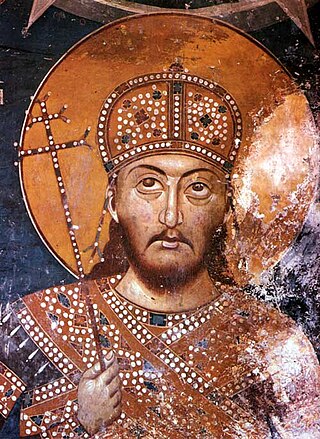
Stefan Uroš IV Dušan, known as Dušan the Mighty, was the king of Serbia from 8 September 1331 and tsar and autocrat of the Serbs, Greeks, Albanians and Bulgarians from 16 April 1346 until his death in 1355.

Dušan's Code is a compilation of several legal systems that was enacted by Stefan Uroš IV Dušan of Serbia in 1349. It drew upon Roman law, Byzantine law, as well as elements of customary and canon law. It was used in the Serbian Empire and the succeeding Serbian Despotate. It is considered an early constitution, or close to it; an advanced set of laws which regulated all aspects of life such as family relations, property rights, contracts, and crimes.

The Serbian Empire was a medieval Serbian state that emerged from the Kingdom of Serbia. It was established in 1346 by Dušan the Mighty, who significantly expanded the state.
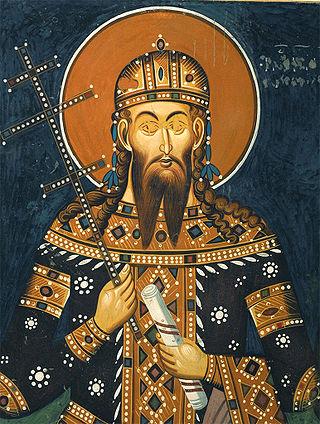
Saint Stefan Uroš V, known in historiography and folk tradition as Uroš the Weak, was the second Emperor (Tsar) of the Serbian Empire (1355–1371), and before that he was Serbian King and co-ruler with his father, Emperor Stefan Dušan.

The House of Nemanjić was the most prominent dynasty of Serbia in the Middle Ages. This princely, royal and imperial house produced twelve Serbian monarchs, who ruled between 1166 and 1371.

Vukašin Mrnjavčević was King of Serbia as the co-ruler of Stefan Uroš V from 1365 to 1371. He was also a nobleman. Principal domains of Vukašin and his family were located in southern parts of medieval Serbia and northwestern parts of the modern region of Macedonia. He died in the Battle of Maritsa in 1371 with his brother, Jovan Uglješa.
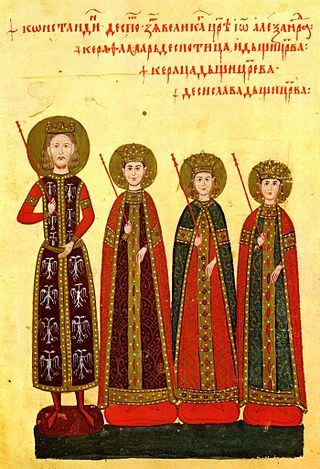
Konstantin (Kostadin) Dejanović or Konstantin Dragaš was a Serbian magnate that ruled a large province in eastern Macedonia under Ottoman suzerainty, during the fall of the Serbian Empire. He succeeded his older brother Jovan Dragaš, who had been an Ottoman vassal since the Battle of Maritsa (1371) which had devastated part of the Serbian nobility. The brothers had their own government and minted coins according to the Nemanjić style. His daughter Jelena married Byzantine Emperor Manuel II Palaiologos in 1392. He fell at the Battle of Rovine, serving the Ottomans against Wallachia, fighting alongside Serbian magnates Stefan Lazarević and Marko Mrnjavčević.

Simeon Uroš, nicknamed Siniša (Синиша), was a self-proclaimed Emperor of Serbs and Greeks, from 1356 to 1370. He was son of Serbian King Stephen Uroš III and Byzantine Princess Maria Palaiologina. Initially, he was awarded the title of despot in 1346, and appointed governor of southern Epirus and Acarnania in 1347 by his half-brother, Serbian Emperor Stephen Dušan. After Dušan's death in 1355, the Serbian throne passed to Dušan's son Stephen Uroš V, but despot Simeon decided to seize the opportunity in order to impose himself as co-ruler and lord of all southern provinces of the Serbian Empire. That led him to conflict with his nephew in 1356, when Simeon started to expand his control in southern regions of the Empire, trying to take Thessaly and Macedonia. He proclaimed himself Emperor of the Serbs and Greeks, creating a separate state, centered in regions of Thessaly and Epirus, where he ruled until his death in 1370. He was succeeded by his son Jovan Uroš.

Autokrator or Autocrator is a Greek epithet applied to an individual who is unrestrained by superiors. It has been applied to military commanders-in-chief as well as Roman and Byzantine emperors as the translation of the Latin title imperator. Its connection with Byzantine-style absolutism gave rise to the modern terms autocrat and autocracy. In Modern Greek, it means "emperor", and its feminine form is autokráteira (αὐτοκράτειρα).

Dejan was a magnate who served Serbian Emperor Stefan Dušan as sevastokrator, and Emperor Uroš V as despot. He was married to Emperor Dušan's sister Teodora, and possessed a large province in the Kumanovo region, east of Skopska Crna Gora. It initially included the old župe (counties) of Žegligovo and Preševo. Uroš V later gave Dejan the Upper Struma river with Velbužd (Kyustendil). Dejan rebuilt the Zemen Monastery, one of Dejan's endowments, among others, as he also reconstructed several church buildings throughout his province.
The Serbian monarchs and royalty have assumed several regnal titles and styles throughout history.
Vojihna or Vojin of Drama, was a Serbian nobleman that rose through the ranks and became one of the most acclaimed military commanders (voivode) and dukes of Stephen Uroš IV Dušan of Serbia during the Serbian Kingdom and Empire (1331–71), he was titled Caesar, hence, he is mostly known as Caesar Vojihna. He held the region of Drama.

The House of Dejanović or House of Dragaš originates from a medieval noble family that served the Serbian Empire of Dušan the Mighty and Uroš the Weak, and during the fall of the Serbian Empire, after the Battle of Maritsa (1371), it became an Ottoman vassal. The family was one of the most prominent during these periods. The family held a region roughly centered where the borders of Serbia, Bulgaria and North Macedonia meet. The last two Byzantine Emperors were maternal descendants of the house.
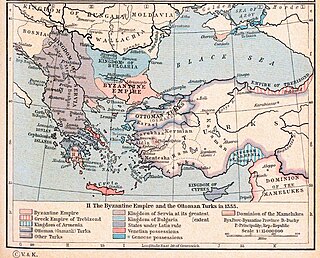
Zeta as a crown land was a medieval region and province of the Serbian state of the Nemanjić dynasty, from the end of the 12th century, up to the middle of the 14th century. During that period, regional administration in Zeta was often bestowed to various members of the ruling dynasty, who administered the region as a crown land.
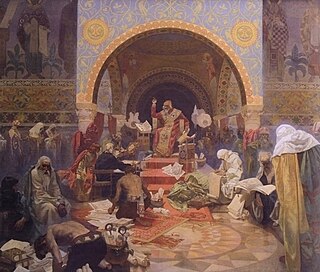
Tsar was a title used by Slavic monarchs. The term is derived from the Latin word caesar, which was intended to mean emperor in the European medieval sense of the term—a ruler with the same rank as a Roman emperor, holding it by the approval of another emperor or a supreme ecclesiastical official —but was usually considered by Western Europeans to be equivalent to "king". It lends its name to a system of government, tsarist autocracy or tsarism.
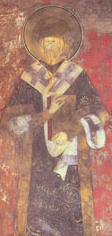
Joanikije II was the Serbian Archbishop (1338–1346) and first Serbian Patriarch (1346–1354). He was elected Serbian Archbishop on January 3, 1338. Prior to his election, he served as a logotet, royal chancellor, to the Kingdom of Serbia. He was elevated to Patriarch on Palm Sunday, April 6, 1346, done in order for Joanikije to crown King Stefan Uroš IV Dušan as Emperor on Easter of 1346 with the approval of the Patriarch of Trnovo, Archbishop of Ohrid, and community of Mount Athos. Joanikije continued a tradition of church building, and built, among others, two churches in the Holy Land: the Church of St. Elias on Mount Carmel and the Church of St. Nicholas on Mount Tabor. Joanikije died on September 3, 1354, which is his feast day. He was buried in the Patriarchal Monastery of Peć.

Gradislav Borilović was a Serbian magnate in the service of Stefan Uroš III Dečanski and Stefan Dušan, having the titles of vojvoda (general), kaznac, and tepčija. Gradislav led the Serbian army that fought the Ottoman emirate at the Battle of Demotika in October 1352. The battle was fought between the allies of the two rival Byzantine Emperors, John V Palaiologos and John VI Kantakouzenos, and it was the first major battle of the Ottomans on European soil, which ended in a Serbian defeat. Greek sources spoke of Gradislav as "truly one of the most respectable among the Serbs".
There has been many regnal styles of Serbian sovereigns.
Vladoje was a Serbian nobleman that served king Stefan Dečanski, with the title of tepčija. He was mentioned in 1326, but most likely began his office at the end of king Stefan Milutin's reign (1282–1321). He succeeded Hardomil, who had served Stefan Milutin as tepčija. King Stefan Dečanski's confirmation on the rights of Ragusan merchants dating to 25 March 1326 was attended by vojvoda Mladen, tepčija Vladoje, and čelnik Đuraš Ilijić. The Serbian court hierarchy was as follows: stavilac, čelnik, kaznac, tepčija and vojvoda, the supreme title. Vladoje marked the boundaries of Belaćevac as an arbitrator in 1326. He was included in the novel Car Dušan (1919) by Vladan Đorđević.
The siege of Serres was fought during the Byzantine civil war of 1341–1347.




















